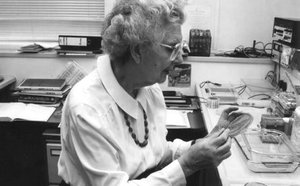Patricia H. Clarke facts for kids
Quick facts for kids
Patricia Clarke
|
|
|---|---|

Patricia Clarke
|
|
| Born |
Patricia Hannah Green
29 July 1919 |
| Died | 28 January 2010 (aged 90) |
| Alma mater | University of Cambridge |
| Spouse(s) |
Michael Clarke
(m. 1940) |
| Children | 2 |
| Awards |
|
| Scientific career | |
| Fields | Biochemistry |
| Institutions | University College London |
Patricia Hannah Clarke (born Green) was a brilliant British scientist. She was a biochemist, which means she studied the chemistry of living things. Patricia was born on July 29, 1919, and passed away on January 28, 2010.
Contents
Early Life and Education
Patricia grew up in Pontypridd, a town in South Wales. She attended Howell's School in Llandaff from 1930 to 1937. After school, she went to Girton College, Cambridge, part of the University of Cambridge. There, from 1937 to 1940, she studied Natural Sciences.
Patricia Clarke's Scientific Career
After finishing her studies, Patricia decided to help with the war effort. She chose to work on explosives at the Ministry of Supply in Swansea. This was instead of doing postgraduate research on ATP metabolism, which is about how living things get energy.
In 1944, she returned to her passion for biochemistry. She joined the Wellcome Trust Research Laboratories. Later, in 1951, she worked part-time at a lab that studied bacteria in London.
Working at University College London
Patricia then joined the Biochemistry Department at University College London. She started as an Assistant Lecturer. She moved up to Lecturer in 1956 and then to Reader in 1966. In 1973, she became a Professor of Microbial Biochemistry. She retired in 1984 and was named an emeritus professor.
During her time there, she co-wrote a book called Genetics and Biochemistry of Pseudomonas. This book helped explain how to use a special method called gas-liquid chromatography in microbiology and medicine.
Key Research and Discoveries
Patricia's main area of research was studying how bacteria produce and use enzymes. Enzymes are like tiny workers in cells that help chemical reactions happen.
Some of her important papers included:
- Hydrogen Sulphide Production by Bacteria
- An Inducible Amidase Produced by a Strain of Pseudomonas Aeruginosa
- Biochemical Classification of Proteus and Providence Cultures
- Butyramide-using Mutants of Pseudomonas Aeruginosa 8602 Which Produce an Amidase with Altered Substrate Specificity
These papers showed her deep understanding of bacterial processes.
After Retirement
Even after retiring, Patricia stayed very active in the scientific world. She held important roles with several groups. These included the Society for General Microbiology, the Biochemical Society, and the Freshwater Biological Association.
Awards and Recognitions
Patricia Clarke received many awards and honors for her amazing work:
- In 1976, she was chosen as a Fellow of the Royal Society (FRS). This is a very high honor for scientists in the UK.
- She gave the famous Leeuwenhoek Lecture in 1979.
- She was the A. J. Klyver Lecturer for the Dutch Society for Microbiology in 1981.
- She gave the Marjory Stephenson Memorial Lecture in 1981.
- From 1981 to 1982, she was the Vice-President of the Royal Society.
- In 1986, she became a Fellow of the International Institute of Biotechnology.
- She received honorary doctorates from the University of Kent (1988) and the Council for National Academic Awards (1990).
- In 1996, she was made an Honorary Fellow of University College London.
- She became an Honorary Member of the Society for General Microbiology in 1997.
Helping Women in Science
Patricia was a strong supporter of scientific groups like the Biochemical Society and the Society for General Microbiology (SGM). She believed these groups helped with education and built a strong science community.
In 1974, she helped create a booklet called Careers in microbiology. The SGM published it to get more students interested in microbiology.
In 1993, Patricia was one of six women on a special committee. This committee looked into why there weren't more women in science and technology. Their report, The rising tide, was published in 1994. It pointed out problems like:
- Not enough female role models in education.
- Employers not giving women fair chances.
- Poor support for maternity leave.
Personal Life
In 1940, Patricia married Michael Clarke. They had two children, born in 1947 and 1949. Patricia passed away at the University of Wales Hospital in Cardiff on January 28, 2010, at the age of 90.

